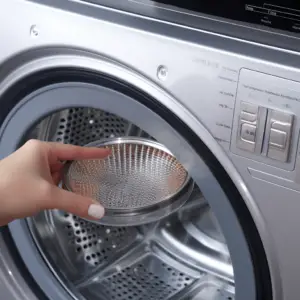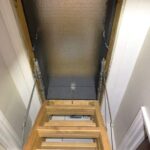Samsung dryer maintenance, To guarantee smooth operation of your Samsung dryer, it’s critical to clean the lint filter routinely. The NC/NC1 code on your dryer’s display or the lint filter warning might serve as reminders to change the filter. In any case, inspect and clean your dryer’s lint filter.
If the filter symbol displays on your Samsung dryer, the lint filter has to be cleaned. Each time you do a load, clean the lint trap.
Using the dryer with a damp lint filter might result in mold growth, unpleasant smells, or a reduction in drying performance. As a result, washing and drying the lint filter after each load is crucial.
However, not every washer/dryer combination has a lint filter. Consult your user manual to see if your washer/dryer includes one. To learn where the lint filter is on your specific model and how to clean it, refer to the instructions below.
After examining and cleaning your Samsung dryer, and the NC/NC1 code still appears, don’t hesitate to get in touch with an authorized service center to get more help.
Table of Contents
Samsung Dryer Lint Trap Problem: How to Clean Lint Filter

- Open the dryer door, then lift the filter up to remove it.
- After removing the filter, keep the rubber sealing in place.
- Remove the inner filter by opening the outer filter.
- Spread the filters out by opening both the inner and outer filters.
- Remove the lint from both filters and give them a thorough brush cleaning.
Reminder: Rinse the filters well under running water, and then properly dry them.
- Insert the internal filter into the exterior filter before repositioning the lint filter.
Reminder: Avoid shaking or tapping the lint filter when cleaning or removing it since doing so might cause damage.
Precautions taken When Using Lint Filter
- Before placing anything in the dryer, ensure the lint filter is appropriately fitted.
- Items can be placed in or removed from the dryer while the lint filter is in place. Small objects may fall into the filter slot if the lint trap is not there, breaking the dryer.
- Each time you finish a load, clean the lint filter. If not, drying efficiency can decrease.
- Before starting the drying cycle, ensure the filter and empty water bottle are cleaned.
- Allow the filter surface to dry fully if it’s damp before use.
- Inserting the filter while it’s wet may result in the growth of mold or unpleasant odors and less drying.
- Avoid shaking or tapping the lint filter when cleaning or removing it since doing so might cause harm to the filter.
Other 2 Common Samsung Dryer Problems
Dryer Making Noise
Another issue with Samsung dryers is an uncomfortable noise, such as rattling, squeaking, or grinding. The dryer belt, idler pulley, broken rollers, or bearings are frequently responsible for the noise.
Damaged Rollers or Bearings in the Drum
Samsung dryer maintenance the drum rollers or bearings are broken, the dryer will create loud, odd noises, often grinding or squeaking. While some dryer models have two rollers in the front and two in the back, others have two in each location.
Additionally, the rollers include bearings, which might cause the axles to wear out. Make sure the rollers can spin freely as you inspect them.
The rollers probably harmed the axles if they were entirely worn out. A damaged roller, axle, or bearing will require replacement.
Rusted Dryer Belt
The pulley system that turns the dryer drum has a dryer belt. When the dryer belt makes a loud thumping noise, it’s worn out or damaged and has to be replaced.
A damaged dryer belt can also be seen in a drum that is difficult to rotate. Unscrew the required access panel to inspect the dryer belt. Replace the belt if it’s damaged or slack.
Faulty Idler Pulley
Samsung dryers have a history of experiencing issues with the idler pulley. The idler pulley maintains tension on the driving belt to protect the drum belt from slipping while the dryer is in use.
Because of friction and the idler pulley’s rapid rotation, Samsung dryer maintenance may eventually wear out. A malfunctioning idler pulley will first generate a loud squeaking sound but may develop a pounding or scraping sound later.
Remove the required access panel and look at the idler pulley to verify it. Look for indications that the pulley bearing is not rotating freely or that the spring mechanism is malfunctioning.
If the problem cannot be resolved by lubricating the bearing, replace the problematic component.
Dryer Not Heating
The situation in which the Samsung dryer is not heating forms part of the most common concerns with Samsung dryers. A burned-out heating element is typically the cause of this issue. However, a blown thermal fuse, a thermistor that isn’t working properly, or a ventilation obstruction might also be to blame.
Faulty Heating Element
A well-maintained dryer should have a heating element that lasts at least 15 years. However, heating problems with Samsung dryers are frequently brought on by a damaged heating element.
Wear and tear and a failure to maintain the ventilation open, which exerts pressure on the heating element, are the two leading causes of heating element burnout.
The coils of the heating element can be visually inspected for damage or grounding. The element probably needs to be replaced if a coil breaks.
A multimeter can also be used to test the element for continuity. Replace the heating element if there is no continuity.
Burned Thermal Fuse
The dryer not heating up due to a blown thermal fuse is another frequent problem with Samsung dryers. A thermal fuse safety feature is intended to keep your dryer from catching fire.
With more recent versions, the dryer stops operating if the temperature rises over a specified point, blowing the thermal fuse. With earlier versions, the dryer could still function but not heat.
Defective Thermocouple or Thermostat
A faulty thermostat or thermistor (temperature sensor) is another typical source of heating issues with Samsung dryers.
A multimeter continuity test is required to identify whether the thermistor or thermostat has to be replaced. The thermostat and thermistor are often found next to the heating element in Samsung models.
Obstructed Ventilation Vent

The dryer will struggle to heat up and may shut off before finishing a cycle if the airflow is obstructed. Make sure the lint screen is clear first.
Next, inspect the ventilation pipe that attaches to the dryer’s rear. Take off the panel covering the ventilation hose to look for further obstructions.
You should clean the external vent that directs air from the dryer to the outside environment at least once a year.
Look for a warm, steady airflow where the ventilation to verify that the outdoor ventilation is functioning. The ventilation can be cleaned using a vacuum attachment or a ventilation cleaning kit.


